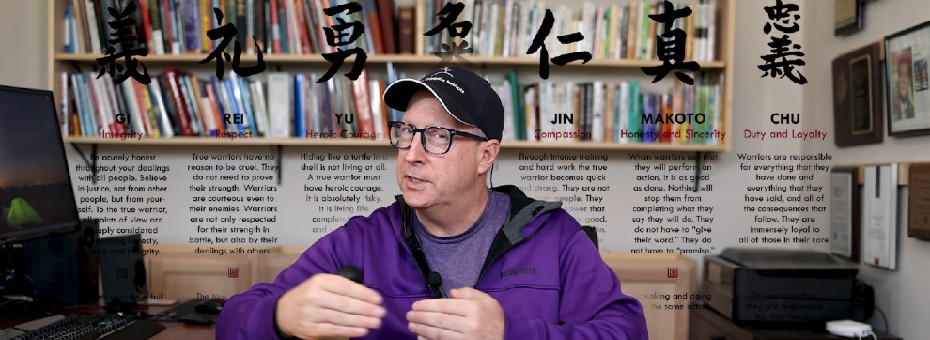Art continues his lessons on coaching with a visit to the world of martial arts, explaining terms like kihon and kata within the contextual realm of lean thinking.
Part three of eight. Watch the others:
Part one, Coaching Problem-Solving
Part two, Lessons from NBA Coaches
Part four, Military Science and Leadership
Part five, Tuckman’s Model of Team Formation
Part six, Team-Building Tools and Practices
Part seven, Dreyfus Model and the Stages of Learning
Part eight, Toyota Coaching Practices
Hi everyone. This is Art Smalley, President of Art of Lean, Incorporated. Today, in conjunction with the Lean Enterprise Institute, I want to bring you another video on the topic of coaching and problem solving. This will continue the series that we started a couple of videos ago and I want to look outside of lane or at least on the periphery of lane and see what else we can learn. Now, last time I used sports and coaching basketball as an analogy. This time let’s look into martial arts and I checked in with several people that I really respect in Japan, people who are accomplished martial artist and trained during their life and also those who spoke work for a long time in Toyota and understood both worlds pretty well. So I’ll share with you what I took from it, and I think it’s going to be interesting to those of you have an interest either in martial arts or lean terms, and we’ll go beyond some of the generics we’re talking about. Stick around, I think you’ll enjoy it.
Kihon, Kata, and Kumite
So, there are a lot of martial arts terms in lane, and I should take a brief moment to explain the three I will predominantly use in this video. Of course, there are more and everybody’s school is a little bit different. It’s tough to reconcile judo. The big three here are dojo, which is a place to practice your school’s way and a safe place to practice kata. There are actually five different conjures for kata that I know. Three apply to martial arts, and that creates confusion because the practitioners in America don’t really distinguish between them. I’m going to say therenare three K’s. Kihon, kata, and kumite. We need to learn them, and we’ll get to those. The last one is the generic coverall term shuhari, which can be thought of as stages of mastery and is really a buildup in the martial arts tradition of Japan or, or Kabuki theater or tea ceremony or calligraphy.
You have long periods of what they call shoe or apprenticeship learning, the basic methods. Following that strictly for many, many years, then at some level, you break that the -ha is the economy for the verb “to break” in a Japanese. That means to break from the form, to do it differently. The last is separation, creating your own form, creating some space in some direction and being different. We throw out that term pretty loosey-goosey in lean, but it’s another way of saying, in my opinion, you have a standard, you’ve got to learn standardized work, and be trained to the standard. You then break that and improve it over time and create a new standard, which is kind of like the process of Kaizen, but there are some good points and bad points of each of these terms.
So, let me try and explain upon them in a way which I think is helpful. I think it could be beneficial if we adopted these, they would help. I do martial arts for full disclosure. I speak, read and write Japanese. I do martial arts, more of the Filipino style of Kali and the Japanese, Brazilian jujitsu, style of grappling and a mixture of some others I’ve messed around with throughout my life. The term “detour” though is the karate one in the United States and so shaved and lean movement. The thing I wish we would actually have started with, or what I learned as the three Ks of karate, there are analogies for this in the Korean Taekwondo system and others as well.
It’s a very specific technique or a couple of techniques you would learn first and you spend a lot of time learning basics first up from Keown or the basics you can then string together. LI have a picture here of a lady starting to do a kata, and there’s 23 steps in it. And there are many techniques within it. Those 23 steps cover many basic techniques, but you have got to learn the basics first and then put them into a kata for self-practice. Okay. That’s really what kata is. Self-practice, solo practice. The third K beyond that is then when you’ve reached a level and your instructor says it’s safe and good, you would go to the third key, where you’re actually grappling. You’re actually wrestling or fighting with somebody in a controlled manner. That’s beneficial to both parties.
One Step at a Time
It’s definitely a bridge, a step up from one K to the next. Different schools and different opinions on this, the school agrees on what the kata are. In the Olympics, they’re going to have kata, sparring, kumite They’re also going to have the kata demonstration of the forms in the Olympics, in Japan. There are only three schools and forums allowed, which is causing some anger and grief among various practitioners because their school, their style, their way is not being included. There is a lot of infighting and factions and karate kind of reminds me of Ling. The thing about that though is again, it builds upon the keyhole and you can’t do kata unless you have mastered the keyhole and or understand them well, I’ve never seen a complete listing of all the wiser Jitsu.
There would be hundreds like in Toyota, I would claim the same to be true, there would also be many kata. And then you would graduate to Kumite after that. But this is all emotion-based. And the point is, if you only know one way of doing things in martial arts or one waza or one set of kata, for example, we consider you a white belt or very low belt or unskilled person, a coach would never claim. We only know one way or one technique or doing things. Within their way, there would be many techniques and many kata and many forms and styles they would build up on to become excellent. It’s very directive. This is not open-ended very directive. The analogy I think is more job instruction and standardized work and Toyota about how to do the job safely, correctly, conscientiously major steps, key points and reasons why it’s not inquiry-based, it’s not open-ended.
We’re not in this part of Shuhari here. Now I would explain it this way. So, somebody who doesn’t know anything about karate or martial arts, let me put it in a more general seven step fashion. This could be basketball for that matter. Number one. Prepare number two, you warm up three. Do some type of kihon or basic style, basic technique, punch block series, or dribbling. If it’s basketball, love, love from there kata where you can string together, many moves and practice by yourself. Many kata exists and in basketball, this would be solo dribbling. For example, go home, practice in your driveway. You’re a crossover between the legs behind the back. Then score a layup at the end. That would be a good example of solo practice. Can we take a level up from there?
You actually grapple. You’ve got to go one-on-one with somebody. It can be safe, can be controlled, rehearsed, slow, medium, or fast. Of course, we can go on to contact sparring where the rules could be 50%, 75% or higher, and you could go on if you want were approved by your teacher and in a competition to 100% full contact competition with the rule set, but going 100%. In basketball, this would now be five-on-five in a tournament or a game situation, but it follows a basic and logical build-up and the style of coaching and things emphasize that each level is it’s slightly different. It’s not one size fits all. There’s oil, boom, Kai, and far more behind this, but no schools are going to agree across schools let alone within one school.
The Context Behind these Analogies
I do think there are K-analogies within Toyota. These are what the expert gentlemen talked and had shared with me within the first K; we actually have dojos in Toyota, where you learn the basics, the kihon or the basics. So you have a stretching area every morning. You have a safety dojo that you learn as a new employee, there’s quality dojo and product dojos that we go to from time to time and refresh our knowledge of the basics. Most importantly, and where Toyotas had a lot of success, the last decade is in the basic job skills, training, dojo offline. So for engine assembly, I know they’ve come up with 24 basic skills that apply to all jobs and assembly of engines, and they teach those very well off the line before you go to work. I wish they had that before. I had done my upper assembly time and engine plant back in Japan, the second K experts I talked to, and I don’t really think there’s a true kata in a Toyota because the kata is solo, it’s invisible or visible, but it’s a solo form of practice, no contact self-practice series of techniques, very specific motion based, and not inquiry-based repetitive.
You do it over and over and you’re graded to a standard just like the Olympics are going to have grades for the content performance. There are grades that tell how well you did the standard. The analogy we all came up with in Toyota and actually the last decade and a half is what’s called the FMDS floor management developed system and it’s a different cottage. The kata for a way to how to do this is where the Japanese gets confusing. I apologize people who don’t speak language and we throw around the kata term, loosey-goosey and let it be anything which is not great. But this kata means what to do, how to do, why to do it means way method or direction. On the job training at Toyota has gotten even better in the last decade and a half that I’ve seen.
It still has some roots in job instruction where you teach the what, the how, and the why structure that demonstrates students learning that the actual job has standardized work to time standards and quality standards. Now, I’ve got various types of rigorous testing, just like there are belt, grading, testing, and forms. You’ve got testing for jobs in Toyota and you’ve got to pass it at the 85% level for work steps, troubleshooting knowledge, and a quality handling defect, handling scrap repair, and the types of things like that. It’s gotten a little more rigorous since when I worked there, to be honest. I think that’s a great development and thing they’ve done, but it’s all on the basics of the jobs still. It’s kind of actually kihon, to be honest with you, but it’s very important. But you could make a kata analogy there if you wanted a level up from that as the third K.
Think of it as a Dojo…
I would approximate this with the daily management system of Toyota, this entire shop floor as a dojo; we go to work and there’s a daily battle. We’re not sparring with each other, but we are sparring in the sense of we have a plan and we’ve got actual results and we’re reconciling the two safety, quality delivery, cost productivity, human resources development. There’s an hourly version of it, a daily, weekly, monthly, and annual version of it. This battle that goes on over the timeframes. This is where I use my analogy of four types of problems are four fighting styles within their troubleshooting for the hourly, quick stuff. We know the problem and basically know the solution, good problem, solving kite to problem solving where we know the problem, but we don’t really know the root cause. We have to study and investigate it for an extended period of time.
Situational application and context matters and expert ability and all this matters.
There’s a third weekly, monthly battle of Kaizen where we know the standard and we know methods to go about improving it, but we have to get to a better solution space going beyond the known style or form. Then there’s a monthly annually Hoshin notion of this longer term where you’re going through bigger breakthroughs and bigger based upon plans that are set up front in the year. It’s not a perfect analogy, but if you were going to throw in the third K and kumite and sparring grappling, I think this makes the most sense from a martial arts comparison point of view. So in summary, I’m going to cut it here at 10 minutes. I’ll probably do a longer 30 minute version of this because there’s actually a lot that I did not cover. But what I like about martial arts and how to organize for practice with many people, there’s a clear way to do that.
There is no One Technique to Rule them all
Structure ability really matters, clearly. Fake instructors in martial arts don’t do well, but they exist. Drills matter, technique and flow drills do too. But I come back to the three K’s; if you’re a beginner or you’re spending all your time on learning the 3 K’s, but you have to demonstrate a kumite before you’re actually, you know, recognized and good in the first two Ks. Then maybe potentially you create their own style. After that, I did have shared with me somewhat cynically and jokingly that Americans don’t like it, that we do the opposite. We break and create our own way first and we break from your way separate first, my and way show, how it’s broken from yours, and then expect you to follow our way.
It’s a little tension between martial arts students and American and Japanese styles, I think. You can say their strengths and weaknesses to both of those, but knowledge matters. You can’t just have one technique. You need many, you can’t just say there’s five or six ability really matters. Situational application and context matters and expert ability and all this matters. The last thing I’ll end with that we all agreed was missing from Kanji and kata and martial arts analogies was that in the end, this is about virtue. It’s finding a peaceful way to do things and better life. The virtues of the way of the warrior Bushido or martial arts get completely neglected, but integrity, respect, courage, honor, compassion, honesty, and loyalty. These are very important things and the way you should aspire to lead your life. I would like us to bring them into the lean world as well if we’re going to invoke martial arts terms. So I hope you found that interesting and useful. I will do a longer one later, but stay safe, have a great day, and we’ll see you in the next video.
Managing to Learn with the A3 Process
Learn how to solve problems and develop problem solvers.






